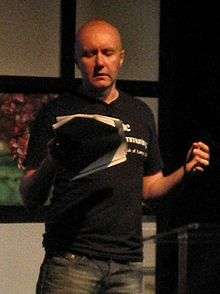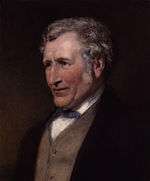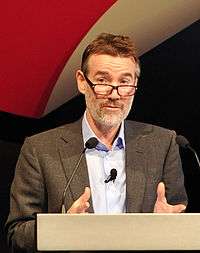Heriot-Watt University
Heriot-Watt University is a public research university based in Edinburgh, Scotland. It was established in 1821 as the School of Arts of Edinburgh, world's first mechanics' institute and subsequently was granted university status by royal charter granted in 1966. It is the eighth oldest higher education institute in UK. The name Heriot-Watt was taken from Scottish inventor James Watt and Scottish philanthropist and goldsmith George Heriot.
 | |
| Motto | Leaders in ideas and solutions |
|---|---|
| Type | Public |
| Established | 1821 - School of Arts of Edinburgh 1852 - Watt Institution and School of Arts 1885 - Heriot-Watt College 1966 – university by Royal Charter |
| Endowment | £8.9m (as of 31 July 2017)[1] |
| Budget | £196.0 million (2016-17)[1] |
| Chancellor | Robert M Buchan |
| Principal | Richard Williams |
| Chairman of Court | Frances Cairncross |
Administrative staff | 1,737[2] |
| Students | Global: 31,000[2] Edinburgh: 10,935 (2018/19)[3] |
| Undergraduates | Edinburgh: 7,905 (2018/19)[3] |
| Postgraduates | Edinburgh: 2,995 (2018/19)[3] |
| Location | , Scotland, United Kingdom |
| Campus | Suburban |
| Other campus locations | Scottish Borders Orkney Dubai Malaysia |
| Affiliations | Association of Commonwealth Universities CESAER ERASMUS Universities Scotland Universities UK |
| Website | www.hw.ac.uk |
Known for its focus on science and engineering, it is one of the 39 old universities in the UK comprising the distinctive second cluster of elite universities after Oxbridge.[4][5]
History
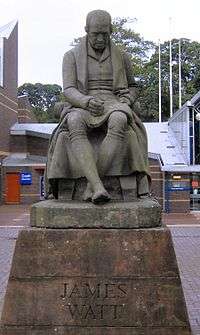
School of Arts of Edinburgh
Heriot-Watt was established as the School of Arts of Edinburgh by Scottish businessman Leonard Horner on 16 October 1821. Having been inspired by Anderson's College in Glasgow, Horner established the School to provide practical knowledge of science and technology to Edinburgh's working men.[6][7]:64–66 The institution was initially of modest size, giving lectures two nights a week in rented rooms[8] and boasting a small library of around 500 technical works.[6][7]:100 It was also oversubscribed, with admissions soon closing despite the cost of 15 shillings for a year's access to lectures and the library.[6]
The School was managed by a board of eighteen directors[6] and primarily funded by sponsors from the middle and upper classes including Robert Stevenson and Walter Scott. It first became associated with the inventor and engineer James Watt in 1824, as a means of raising funds to secure permanent accommodation. Justifying the association, School Director Lord Cockburn said:
"[The building] shall be employed for the accommodation of the Edinburgh School of Arts; whereby the memory of Watt may forever be connected with the promotion, among a class of men to which he himself originally belonged, of those mechanical arts from which his own usefulness and glory arose.[7]:103 "
In 1837, the School of Arts moved to leased accommodation on Adam Square, which it was able to purchase in 1851 thanks to funds raised in Watt's name. In honour of the purchase, the School changed its name to the Watt Institution and School of Arts in 1852.
Watt Institution and School of Arts
Heriot-Watt's time as the Watt Institution marked a transitional period for the organisation, as its curriculum broadened to include several subjects beyond mathematics and the physical sciences. While the School of Arts had catered almost exclusively to working-class artisans and technical workers, the Watt Institution admitted a large number of middle-class students, whom it attracted with new subjects in the sciences, social sciences and humanities. By 1885, the skilled working class were no longer the majority in an institution that had been created explicitly for them.[7]:133–135
A shifting class make-up was not the only demographic change to affect the student body, as in 1869 women were permitted to attend lectures for the first time. This move put the Watt Institution some way ahead of Scottish universities, who were only permitted to allow women to graduate 20 years later following the Universities (Scotland) Act of 1889.[9]:163 The decision to admit women was made in large part owing to pressure from local campaigner Mary Burton, who later became the Institution's first female director in 1874.[7]:133–135[10]
In 1870, the Watt Institution was forced to move following the demolition of Adam Square.[7]:148–153 After a brief period on Roxburgh Place, it relocated to the newly constructed Chambers Street near where its former site had stood. The move caused the Institution severe financial difficulties, which were compounded by a combination of declining funds from subscribers and increased costs from its growing student body. In 1873, the Directors turned to George Heriot's Trust for support, and agreed to a merger of the Trust's endowment with the Institution's own. The proposed merger was provisional to changes in the structure of the Watt Institution, which would see the organisation become a technical college with representatives of the Trust in management positions. Accepting these changes, the Watt Institution officially became Heriot-Watt College in 1885, and was subsequently on far firmer financial ground.[7]:160–161
The Watt Club
The Watt Club was founded at the Watt Institution on 12 May 1854, and is today the oldest alumni organisation in the UK.[11] Following the unveiling of a statue of James Watt outside the Institution, local jeweller J.E Vernon proposed that
"[a club should be formed] whose object would be to sup together on the anniversary of the birth of James Watt…and also to promote the interests of the School, by raising a fund each year to provide prizes.[7]:144–145"
Watt Club Medals are still awarded by the organisation each year to Heriot-Watt's most highly achieving students, while the Watt Club Prize is awarded by The Watt Club Council to recognise student initiative and enterprise.[12]
Heriot-Watt College
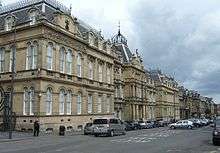
After the establishment of Heriot-Watt as a technical college, the new management committee set about extending the institution's buildings and strengthening its academic reputation.[13] In its new form the college was one of only three non-university institutions in the UK with the power to appoint professors, and the first of these was appointed in 1887. In 1902 the College became a central institution, while in 1904 it introduced awards for graduating students which were similar to university degrees.[13]
Expansion meant that the college made increasing demands on George Heriot's Trust throughout the first part of the 20th century, which ultimately led to the independence of the two bodies in 1927. While the Trust continued to pay Heriot-Watt a fixed sum each year, from then on the college was responsible for managing its own financial affairs.[13] Heriot-Watt continued to expand after becoming independent, opening a new extension in 1935.[7]:243
Both World Wars impacted on the speed of the college's expansion. During World War I, student numbers dropped as young men joined the army, while teaching in engineering stalled as the department was used for the manufacture of shells and munitions.[7]:213–215 During World War II, student numbers dropped again and the electrical engineering department became involved in training the armed services in the use of radar.
After the College introduced a postgraduate award in 1951, it offered awards equivalent to university degrees and doctorates in all practical respects. Recognising this, in 1963 the Robbins Report recommended that it should be awarded university status. On 1 February 1966 the recommendation was enacted, as the institution officially became Heriot-Watt University.[13]
Heriot-Watt University
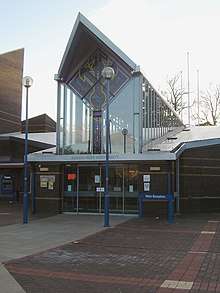
The first personal chair was appointed in 1974.[14]
While Heriot-Watt continued to expand in the centre of Edinburgh after attaining university status, the institution had grown big enough that relocation was felt to be desirable.[13] In 1966 Midlothian County Council gifted the Riccarton estate north of Currie to the University and in 1969 work began on transforming the site into a future campus.[7]:252 The process of relocation to Riccarton continued until 1992, with teaching and facilities divided between the new campus and the city centre until this time.[7]:379–381
The University has continued to grow after completing its move to Riccarton, constructing additional student halls, a sports centre and a postgraduate centre on the site. The institution also expanded beyond Edinburgh, merging with the Scottish College of Textiles to create a campus in the Scottish Borders in 1998, opening a campus in Dubai in 2006[7]:436–441 and a campus in Putrajaya, Malaysia, in 2012.[15]
In recent years, the University's campus in Edinburgh has benefited from major infrastructural projects worth £60 million, with another £68 million worth investment announced. These include the UK's first purpose-built graduate centre (£6 million),[16] Scotland's elite Oriam Sports Performance Centre facility (£33 million),[17] and the UK's first FlexBIO flexible downstream bioprocessing centre (£2 million).[18] It is also constructing a 5,000m² Watt Innovation Building supporting Global Research, Innovation and Discovery [GRID][17] to boost 'creativity and ideas generation' on the University's growing Edinburgh campus. GRID is a new ground-breaking facility to advance our global research, innovation and discovery. It has been designed to create cohesion between academic disciplines, industry partners and the global community, providing an innovative teaching and learning environment for mathematics, engineering, physical sciences and computer science students and staff. The University has plans to host a major £65 million film studio[19] and a £2.5 million academic partnership with the oil and gas firm TOTAL S.A..[20] However, in 2017 it was also announced that a major budget shortfall and the impact of Brexit would result in Heriot-Watt shedding 100 jobs by voluntary redundancies.[21]
Campuses
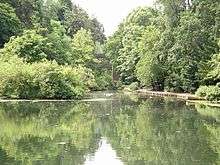
Heriot-Watt currently has five campuses, and also runs distance learning programmes through 53 approved learning partners to students around the world.[22]
Edinburgh
Heriot-Watt's main campus is located in Riccarton in South West Edinburgh on 380 acres of parkland. The campus consists of: academic buildings, student residences, a postgraduate centre, shops, several library collections, childcare, healthcare, a chaplaincy, a variety of recreational and sports facilities, and a museum, as well as the Student Union's main premises.[23] It is also home to the Edinburgh Conference Centre and Europe's oldest research park, Heriot Watt University Research Park which opened in 1971.[7]:386 The University's Institute of Petroleum Engineering is based at its Edinburgh campus.[24]
Scottish Borders
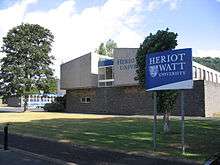
Heriot-Watt's Scottish Borders Campus in Galashiels is home to the University's School of Textile and Design.[25] The School began life in 1883 when the Galashiels Manufacturer's Corporation began running classes in practical courses for its workers. The institution gradually grew both in terms of student numbers and the number of courses it offered, and it ultimately became known as the Scottish College of Textiles in 1968. In 1998 the College merged with Heriot-Watt, leading to the creation of the School of Textiles and Design in its modern form.[7]:436–444
The School is one of the few fashion schools in the world which offers a menswear course at bachelor's degree level, and the only school in Scotland to offer a fashion communication course. It was ranked 11th place in the UK for art and design in the 2013 Complete University Guide,[26] produced a winner and five other finalists for the Scottish Fashion Awards Graduate of the Year in June 2012.[27]
While the Scottish Borders Campus shares some facilities and administrative functions with Edinburgh, it is largely self-contained. As well as its own library, accommodation and catering facilities,[28] it has its own branch of the Student Union which runs events on the site[29] and is home to a collection of textile records and artefacts.[30] A new £12m student village opened at the Campus in September 2012.[31]
The entire campus is shared with Borders College, whose students make up the majority of those who study at the site.
Marillion's 1985 song Kayleigh was inspired by an SCT student, and refers to the snow and college halls of Galashiels.[32]
Dubai
Heriot-Watt' s Dubai Campus opened in 2005. It was the first British university to set up in Dubai International Academic City.[33]
Offering a range of undergraduate and postgraduate courses similar to those found in Scotland, the Campus facilitates student exchanges between Britain and the Emirates. It has facilities including a library, catering, computer access and shops.[34] An expanded campus opened in the city in November 2011, allowing double the number of students to study for a Heriot-Watt degree in the city.[35]
Malaysia
Heriot-Watt University Malaysia's purpose-built campus opened in Putrajaya in September 2014, £35 million was invested in the Malaysian campus, which is the first 'green campus' in the country. It is situated in a lakeside location of 4.8 acres offering undergraduate as well as master's degree.[36]
Orkney
Heriot-Watt's campus in Stromness, Orkney, is home to the International Centre for Island Technology (ICIT), part of the University's Institute of Petroleum Engineering. The Campus provides education to a small number of postgraduate students and is host to eight members of research staff.[37][38]
Organisation
Heriot-Watt is divided into six schools and one institute that coordinate its teaching and research:
- The School of Energy, Geoscience, Infrastructure and Society, incorporating petroleum engineering and renewable energy technology, architectural engineering, civil & structural engineering, construction management & surveying, geography and urban studies;[39]
- The School of Engineering and Physical Sciences, incorporating chemical engineering, chemistry, electrical, electronic and computing engineering, mechanical engineering and physics;[40]
- The School of Social Sciences (formerly, School of Management and Languages), incorporating accountancy and finance, business management, economics and languages;[41]
- The School of Mathematical and Computer Sciences, incorporating actuarial mathematics and statistics, computer science and mathematics;[42]
- The School of Textiles and Design;[43]
- Edinburgh Business School, which offers postgraduate courses at MBA, MSc and DBA level;[44]
- The Urban Institute, which is a research collaboration for urban studies between Heriot-Watt University and The University of Edinburgh
From 1 August 2016, the former School of Life Sciences was merged with other schools, with programmes transferred to the School of Management and Languages, the School of Energy, Geoscience, Infrastructure and Society and the School of Engineering and Physical Sciences.[45]
Academic profile
Rankings and reputation
| National rankings | |
|---|---|
| Complete (2021)[46] | 35 |
| Guardian (2020)[47] | 61 |
| Times / Sunday Times (2020)[48] | 33 |
| Global rankings | |
| ARWU (2019)[49] | 501-600 |
| CWTS Leiden (2019)[50] | 319 [51] |
| QS (2020)[52] | 314 |
| THE (2020)[53] | 251–300 |
| British Government assessment | |
| Teaching Excellence Framework[54] | Silver |
| ARWU Subject rankings (World)[55] | |
|---|---|
| Civil Engineering[56] | 101-150 |
| Electrical Electronic Engineering[57] | 201-300 |
| Finance[58] | 151-200 |
| Mathematics[59] | 101-150 |
| Mechanical Engineering[60] | 201-300 |
| Oceanography[61] | 101-150 |
| Telecom Engineering[62] | 51-75 |
Heriot-Watt University was named International University of the Year[63] by The Times and Sunday Times Good University Guide 2018. Heriot-Watt is known for the strong prospects of its students, with 80% in graduate-level jobs or further study six months after leaving the institution.[64]
In 2011, Heriot-Watt was named as the Sunday Times Scottish University of the Year 2011–2012, with the paper emphasising the employability of the institution's graduates.[64] In 2012, it was again Scottish University of the Year 2012–2013 for the second year running, and also became UK University of the Year for student experience.[65] The same year it came 1st in Scotland and 4th in the UK in the 2012 National Student Survey.[64]
Times Higher Education's 'Table of Tables' is the combined results of the three main UK university league tables - the Good University Guide (published by The Times and The Sunday Times), The Guardian and The Complete University Guide. In the Table of Tables 2015, Heriot-Watt was placed 27th in the UK and 3rd in Scotland. It is ranked 28th in the UK by The Complete University Guide 2018 and 26th in the UK by The Guardian University League Table 2018.[66] In a 2015 detail report on UK universities, Durham academic Vikki Boliver placed Oxford and Cambridge in the first tier, and included Heriot-Watt in the second tier made of the remaining 22 Russell Group universities and 17 other "pre-92" universities.[4][5]
In 2020, Heriot-Watt was ranked at 314 by QS World University Rankings and at 251-300 by Times Higher Education World University Rankings in the world. It was ranked 243rd in the world for engineering and technology by QS Rankings in 2019.[67] It was ranked 143rd in the world for technical sciences in 2018 by Round University Ranking.[68]
In 2017, Business Insider ranked Heriot-Watt the 3rd best UK university to study Economics.[69] It was ranked among 201-250 globally for Business and Economics by Times in 2019.[70] In 2018, ARWU ranked Heriot-Watt globally among 51-75 for Telecom Engineering and 101-150 for Civil Engineering, Mathematics and Oceanography.[71]
Nationally, the university is ranked highly for Planning and Building education. In 2019, the university was ranked 4th in UK and 1st in Scotland for Town & Country Planning and Landscape Design by The Complete University Guide.[72] It was also ranked 9th in UK and 1st in Scotland for Building and Town & Country Planning by the Guardian in the same year.[73] In the 2019 The Complete University Guide national subject rankings Heriot-Watt had the following rankings: 2nd (of 34) - Building education,[74] 17th (of 104) - Accounting and Finance, 15th (of 81) - Art and Design, 14th (of 30) - Chemical Engineering,[75] 23rd (of 60) - Chemistry,[76] 1 (of 56) - Civil Engineering,[77] 25th (of 110) - Computer Science,[78] 22nd (of 77) - Economics,[79] 23rd (of 68) - Electrical Engineering,[72] 15th (of 72) - Mathematics,[80] 14th (of 69) - Mechanical Engineering,[81] and 25th (of 48) - Physics and Astronomy.[72] The university has been constantly ranked among the top 10 universities in UK for Building education since 2010.[82]
Admissions
| 2017 | 2016 | 2015 | 2014 | 2013 | |
|---|---|---|---|---|---|
| Applications[83] | 11,450 | 12,735 | 13,865 | 13,320 | 13,340 |
| Offer Rate (%)[84] | 90.6 | 89.2 | 81.9 | 79.6 | 82.7 |
| Enrols[85] | 2,135 | 2,070 | 1,885 | 1,840 | 2,145 |
| Yield (%) | 20.6 | 18.8 | 16.6 | 17.4 | 19.4 |
| Applicant/Enrolled Ratio | 5.36 | 6.15 | 7.36 | 7.24 | 6.20 |
| Average Entry Tariff[66][lower-alpha 1] | n/a | 163 | 407 | 406 | 411 |
As of February 2017, approximately 13,700 student are enrolled at one of Heriot-Watt's campuses: 66.6% in Scotland, 24.2% in Dubai and 9.2% in Malaysia. In the Scotland campus, the university has a female:male ratio of 41:59.[86]
Masters in Strategic Project Management
Under the framework of the European Education system and as part of the Erasmus Mundus program Heriot-Watt University offers a Masters in Strategic Project Management jointly with Politecnico di Milano (Italy) and Umeå University (Sweden).[87] Students in the program study at all three institutions over two years and at the conclusion receive degrees issued by all three. The program ranks number 11 in the Eduniversal Bests Masters Ranking and number 25 in the QS World University Rankings worldwide.[88][89]
Student life
Student Union
The Student Union at Heriot-Watt is a student-led organisation headed by individuals elected from the student population. The association has represented students both locally and nationally since its foundation in 1966,[90] and is a member of both the Edinburgh Students' Forum and the National Union of Students (NUS).[91] It is also responsible for running the University's Student Union, which runs events for students and supports student societies. Over 50 societies currently exist, including the Brewing Society which organises an annual charity beer festival.[92] In addition, the Student Union runs several services at the Edinburgh and Scottish Borders campuses including catering facilities, a nightclub, an advice centre and a student shop.[93] The Student Union also works closely with the Heriot-Watt University Dubai Student Council[94] and the Heriot-Watt University Malaysia Student Association.[95] The Student Union recently won the University Student Union of the Year 2018, and Officer Team of the Year 2018 at the NUS Scotland Awards 2018.[96]
Notable alumni
Arts
- Theodore S. Clerk, (1909-1965), city planner, first Ghanaian architect and developer of the port city of Tema
- Sir Nicholas Grimshaw (born 1939), architect of the Eden Project, president of the Royal Academy since 2004
- Sir Robert Matthew (1906–1975), designed the Royal Commonwealth Pool and founded RMJM
- Patrick Nuttgens (1930–2004), academic and writer on architecture
- Sir Basil Spence (1907–1976), architect of Coventry Cathedral and the New Zealand Parliament Building (nicknamed 'The Beehive') in Wellington, New Zealand
- Sir William Kininmonth (1904–1988), architect of Adam House and Pollock Halls, both in Edinburgh
- Sir James Dunbar-Nasmith (born 1927), conservation architect and head of ECA's Department of Architecture 1978–1988
- Rab and Denise Bennetts, founders of Bennetts Associates
- John McAslan, architect
- Kygo, Norwegian DJ and record producer
- Dame Muriel Spark, British writer (took a course in commercial correspondence and précis writing at Heriot-Watt College)
- John Thomson, pioneering photographer
- Deepak Tripathi, historian and former journalist
- Irvine Welsh, British writer of the novel Trainspotting
- Greg Wise, British actor and producer
- Joanne Yeoh, Malaysian violinist and music lecturer at Universiti Putra Malaysia
- Gary Younge, writer and journalist
Academia and science
- Iain Baikie, Physicist winner of Swan Medal and Prize
- Christina Miller, chemist
- James Nasmyth, inventor of the steam hammer[99]:93
- Sarah Tabrizi, neurologist
- Le Hai An (1971-2019), The late Deputy Minister of Education and Training of Vietnam and rector of Hanoi University of Mining and Geology.
Business
- Robert Buchan, British/Canadian businessman, founder of Kinross Gold Corporation
- Adam Crozier, British businessman, chief executive and television executives; Chief Executive of ITV
- Roger Jenkins, British financier, former Chief Executive of Barclays Private Equity, Principal Investments and Structured Capital Markets
- Bob Keiller, British businessman, Chief Executive of Wood Group
- Michael Lombardi, Canadian businessman, founder of Lombardi Media Corporation
- Ian Ritchie, British businessman, founder of OWL, missed WWW opportunity of Tim Berners-Lee[100]
- Maurice Tulloch (born 1969), British/Canadian businessman, CEO of Aviva[101]
- Mason Maruszak-Webster (born 1998). British/Polish entrepreneur.
Politics
- Nathif Jama Adam, Somali banker and politician
- Sarah Boyack, former MSP and Minister for Transport of Scotland
- Ingvald Godal, former Member of the Norwegian Parliament and former Chairman of the Norwegian Support Committee for Chechnya
- Bernie Grant, British Labour Party politician, the Member of Parliament for Tottenham from 1987 to 2000; Britain's first Afro-Caribbean MP (did not graduate)
- Fiona Hyslop MSP, Cabinet Secretary for Culture and External Affairs in the Scottish Government
- Hassan Ali Khaire, Somali politician, Prime Minister of Somalia[102]
- Archy Kirkwood, Baron Kirkwood of Kirkhope, former Liberal Democrat MP
- Mark MacGregor, Conservative Party politician
- Brian Monteith, former Conservative MSP
- Teo Ho Pin, Member of the Singapore Parliament
- Henning Skumsvoll, Member of the Norwegian Parliament
- Graham Watson, former MEP and President of the European Liberal Democrat and Reform Party
- Lord Mike Watson, Baron Watson of Invergowrie, former MP and MSP
Sports
- Jock Clear, Formula One engineer[103]
- Keith "Swaz" Fraser, Olympic skier (Graduated 1991 with MEng in Civil Engineering)
- Lee Jones, current member of the Scotland national rugby union team[104]
- Shirley Robertson, TV presenter and double Olympic gold medallist
- Jack Ross, British professional footballer
- Gordon Shedden, British auto racing driver
Other
- Liam Burns, NUS UK President 2011–13
- Ian Dunn, gay and paedophile rights activist, founder of the Scottish Minorities Group[105]
- Fiona Watson, political affairs officer
Notable staff
- Sir Thomas Hudson Beare, FRSE, RSSA, chair of mechanics and engineering, 1887–1889
- George Murray Burnett, FRSE (1921–1980) served as Principal 1974 until 1980.[106]
- Andrew John Herbertson, lecturer in industrial and commercial geography, 1896–1899[107]
- Sir Geoff Palmer, OBE, grain scientist and human rights advocate, 1977–2005
Principals
- Sir Francis Grant Ogilvie, CB, FRSE, 1886–1900
- Arthur Pillans Laurie, FRSE, 1900–1928
- James Cameron Smail, OBE, FRSE, 1928–1950
- Hugh Bryan Nisbet, CBE, FRSE, 1950–1967
- Robert Allan Smith, CBE, FRS, PRSE, 1968–1974
- George Murray Burnett, FRSE, 1974–1980
- Thomas Lothian Johnston, PRSE, 1981–1988
- Sir Alistair George James MacFarlane, CBE, FRS, FRSE, 1989–1996
- John Stuart Archer, CBE, FRSE, 1997–2006
- Sir Vito Antonio Muscatelli, CBE, FRSE, 2007–2009
- Steven Kenneth Chapman, CBE, FRSE, 2009–2015
- Richard Andrew Williams, OBE, FRSE, 2015–present
References
- New UCAS Tariff system from 2016
- "Annual Accounts 2017" (PDF). Heriot-Watt University. Retrieved 8 August 2018.
- "Annual statistics 2011–12" (PDF). Retrieved 10 August 2012.
- "Where do HE students study?". Higher Education Statistics Agency. Retrieved 1 March 2020.
- Boliver, Vikki (2015). "Are there distinctive clusters of higher and lower status universities in the UK?" (PDF). Oxford Review of Education. 41 (5): 608–627. doi:10.1080/03054985.2015.1082905.
- Havergal, Chris. "Most Russell Group universities 'little different to other pre-92s' | Times Higher Education (THE)". Times Higher Education. Retrieved 14 June 2016.
- Jameson, R (1824), "Some Account of the School of Arts of Edinburgh.", The Edinburgh Philosophical Journal, 11: 203–205
- O'Farrell, P. N. (2004). Heriot Watt University: An Illustrated History. Pearson Education Limited. ISBN 0-273-69605-X
- "GASHE: School of Arts, Edinburgh". Retrieved 25 May 2012.
- Barnett, H. (2011). Constitutional & Administrative Law (8th Edition). Routledge. ISBN 978-0415578813
- "Gazetteer for Scotland: Mary Burton". Retrieved 6 December 2011.
- "Heriot-Watt University: A Short History of the Watt Club". Retrieved 6 December 2011.
- "Heriot-Watt Academic Registry: Prizes and Awards". Retrieved 19 June 2012.
- "Records of Heriot-Watt College". NAHSTE. Archived from the original on 6 September 2002. Retrieved 6 December 2011.
- "Heriot Watt's new professor". The Glasgow Herald. 29 June 1974. p. 11. Retrieved 8 June 2017.
- "Heriot-Watt University: Official Opening of Heriot-Watt University Malaysia". Retrieved 3 December 2012.
- RIAS. "Post Graduate Centre, Heriot-Watt University : RIAS". www.rias.org.uk.
- "Heriot-Watt University seeks architect for £19m innovation centre".
- "£1.7m new centre at Heriot-Watt University will let biotechnology firms scale up in Scotland". The National.
- "Wait years for a film studio… then two come along at once". HeraldScotland.
- "Heriot-Watt University signs £2.5m partnership deal". BBC News.
- "BBC".
- "Heriot-Watt University: Study in your own country". Retrieved 29 November 2011.
- "Heriot-Watt University: Facilities at Edinburgh Campus". Retrieved 18 May 2012.
- "Institute of Petroleum Engineering". www.pet.hw.ac.uk. Retrieved 26 March 2019.
- "Heriot-Watt University: Scottish Borders Campus". Retrieved 25 May 2012.
- "Complete University Guide 2013: Art and Design". Retrieved 25 May 2012.
- "The Scotsman: Scottish Fashion Awards: The winners in full". The Scotsman. Retrieved 14 August 2015.
- "Heriot-Watt University: Scottish Borders Campus". Retrieved 21 May 2012.
- "Heriot-Watt Student Union:SBC Homepage". Archived from the original on 17 May 2012. Retrieved 23 May 2012.
- "University guide 2013: Heriot-Watt University". The Guardian. 10 May 2009. Retrieved 25 May 2012.
- "Accommodation at Scottish Borders Campus". Heriot-Watt University. Retrieved 24 May 2012.
- "Rock star 'humbled' by lyrics carved into new Gala stonework". The Southern Reporter. Archived from the original on 13 July 2019. Retrieved 22 June 2020.
- "Heriot-Watt website".
- "Heriot-Watt University: Facilities at Dubai Campus". Archived from the original on 4 January 2012. Retrieved 23 May 2012.
- "Scottish internationalism: Salmond welcomes Heriot-Watt's Dubai campus". Times Higher Education. Retrieved 20 June 2012.
- "Location". Heriot-Watt. Retrieved 16 July 2015.
- "Courses". ICIT. Retrieved 30 November 2011.
- "Staff". ICIT. Retrieved 30 November 2011.
- "School of Energy, Geoscience, Infrastructure and Society". Retrieved 16 July 2015.
- "Heriot-Watt University: School of Engineering and Physical Sciences". Retrieved 21 May 2012.
- "Heriot-Watt University: School of Management and Languages". Retrieved 21 May 2012.
- "Heriot-Watt University: School of Mathematical and Computer Sciences". Retrieved 21 May 2012.
- "Heriot-Watt University: School of Textiles and Design". Retrieved 21 May 2012.
- "Edinburgh Business School". Retrieved 21 May 2012.
- "Heriot-Watt University: School of Life Sciences". Retrieved 5 August 2016.
- "University League Table 2021". The Complete University Guide. 1 June 2020.
- "University league tables 2020". The Guardian. 7 June 2019.
- "The Times and Sunday Times University Good University Guide 2020". Times Newspapers.
- "Academic Ranking of World Universities 2019". Shanghai Ranking Consultancy.
- "CWTS Leiden Ranking 2019 - PP top 10%". CWTS Leiden Ranking 2019.
- Leiden Ranking 2018 Indicators: p,p (top 5%), pp (top 5%); Order by: pp (top 5%)
- "QS World University Rankings 2020". Quacquarelli Symonds Ltd.
- "World University Rankings 2020". Times Higher Education.
- "Teaching Excellence Framework outcomes". Higher Education Funding Council for England.
- "ARWU subject ranking". Academic Ranking of the World Universities. Retrieved 14 March 2019.
- "ShanghaiRanking's Global Ranking of Academic Subjects 2018 - Civil Engineering - Shanghai Ranking - 2018". www.shanghairanking.com.
- http://www.shanghairanking.com/Shanghairanking-Subject-Rankings/electrical-electronic-engineering.html
- "ShanghaiRanking's Global Ranking of Academic Subjects 2018 - Finance - Shanghai Ranking - 2018". www.shanghairanking.com.
- "ShanghaiRanking's Global Ranking of Academic Subjects 2018 - Mathematics - Shanghai Ranking - 2018". www.shanghairanking.com.
- "ShanghaiRanking's Global Ranking of Academic Subjects 2018 - Mechanical Engineering - Shanghai Ranking - 2018". www.shanghairanking.com.
- "ShanghaiRanking's Global Ranking of Academic Subjects 2018 - Oceanography - Shanghai Ranking - 2018". www.shanghairanking.com.
- "ShanghaiRanking's Global Ranking of Academic Subjects 2018 - Telecommunication Engineering - Shanghai Ranking - 2018". www.shanghairanking.com.
- "Heriot-Watt University Named International University of the Year".
- The Sunday Times University Guide 2012, 11-09-2011. Leonard, Sue, "Full steam ahead for Heriot-Watt", London.
- "BBC News: Scottish University of the year". Retrieved 28 September 2012.
- "Our rankings". hw.ac.uk. Heriot-Watt University. 2018.
- "Engineering and Technology". Top Universities. 15 February 2019.
- "Subject Rankings". roundranking.com.
- UK, Will Martin, Business Insider. "The 13 best universities in Britain to study economics". Business Insider.
- "World University Rankings 2019 by subject: business and economics". Times Higher Education (THE). 8 October 2018.
- "ShanghaiRanking's Global Ranking of Academic Subjects 2018 - Shanghai Ranking - 2018". www.shanghairanking.com.
- "Top UK University League Tables and Rankings 2020". www.thecompleteuniversityguide.co.uk.
- "University league tables 2019". the Guardian.
- "Building - Top UK University Subject Tables and Rankings 2019". www.thecompleteuniversityguide.co.uk.
- "Chemical Engineering - Top UK University Subject Tables and Rankings 2019". www.thecompleteuniversityguide.co.uk.
- "Chemistry - Top UK University Subject Tables and Rankings 2019". www.thecompleteuniversityguide.co.uk.
- "Civil Engineering - Top UK University Subject Tables and Rankings 2019". www.thecompleteuniversityguide.co.uk.
- "Computer Science - Top UK University Subject Tables and Rankings 2019". www.thecompleteuniversityguide.co.uk.
- "Economics - Top UK University Subject Tables and Rankings 2019". www.thecompleteuniversityguide.co.uk.
- "Mathematics - Top UK University Subject Tables and Rankings 2019". www.thecompleteuniversityguide.co.uk.
- "Mechanical Engineering - Top UK University Subject Tables and Rankings 2019". www.thecompleteuniversityguide.co.uk.
- "Building - Top UK University Subject Tables and Rankings 2010". www.thecompleteuniversityguide.co.uk.
- "End of Cycle 2017 Data Resources DR4_001_03 Applications by provider". UCAS. UCAS. 2017. Retrieved 25 January 2018.
- "Sex, area background and ethnic group: H24 Heriot-Watt University Edinburgh". UCAS. UCAS. 2017. Retrieved 25 January 2018.
- "End of Cycle 2017 Data Resources DR4_001_02 Main scheme acceptances by provider". UCAS. UCAS. 2017. Retrieved 25 January 2018.
- "Heriot-Watt University Student Data Summary" (PDF). hw.ac.uk. Heriot-Watt University.
- Calabrese, Antonio (29 March 2013). "Master in Strategic Project Management (European), a Worldwide Experience". Procedia - Social and Behavioral Sciences. 74: 488–497. doi:10.1016/j.sbspro.2013.03.051. ISSN 1877-0428.
- "MIP Politecnico di Milano School of Management - Master in Strategic Project Management (European) - MSPME". Eduniversal Best Masters ranking worldwide. Retrieved 25 December 2017.
- "QS World University Rankings: Masters in Management Rankings 2018". QS World University Rankings. Retrieved 20 February 2018.
- "Heriot-Watt Student Union: History". Archived from the original on 22 July 2012. Retrieved 21 May 2012.
- "Heriot-Watt Student Union: What is Representation?". Archived from the original on 17 May 2012. Retrieved 21 May 2012.
- "Heriot-Watt Student Union: A-Z of Societies". Archived from the original on 18 April 2012. Retrieved 30 April 2012.
- "Heriot-Watt Student Union: Services". Archived from the original on 17 May 2012. Retrieved 21 May 2012.
- "Heriot-Watt University Dubai Student Council". Retrieved 15 May 2018.
- "Heriot-Watt University Malaysia Student Association". Retrieved 15 May 2018.
- "Winners of NUS Scotland Awards 2018". Retrieved 15 May 2018.
- "Heriot-Watt University: Sports Union Clubs". Retrieved 21 May 2012.
- "Heriot-Watt University: Sports Union". Retrieved 21 May 2012.
- Nasmyth,J. (1885, reprinted 2010). James Nasmyth, Engineer: An Autobiography. BoD – Books on Demand. ISBN 3867414599
- "Coppertop: Ian Ritchie's home page".
- "Maurice Tulloch, Chief Executive Officer". Aviva. Retrieved 5 October 2019.
- "Hassan Ali Khaire, an Oil Executive, Is Picked to Be Somalia's Prime Minister". The New York Times. 23 February 2017. Retrieved 5 March 2017.
- "Doctorate for Formula One mechanic". The Scotsman. Retrieved 21 June 2012.
- "Lee Jones". Edinburgh Rugby. Archived from the original on 30 April 2012. Retrieved 16 April 2012.
- https://web.archive.org/web/20170315224225/http://www.scotsgay.co.uk/io20a/obit.html
- "Microsoft Word - oldfells_list_jun06.doc" (PDF). Retrieved 14 June 2016.
- White, Chris. "Remembering Andrew John Herbertson (1865-1915) - News - School of Geography and the Environment - University of Oxford". www.geog.ox.ac.uk.
External links
![]()
